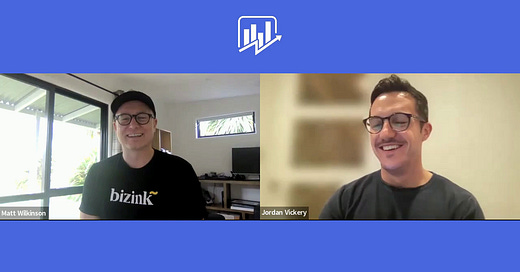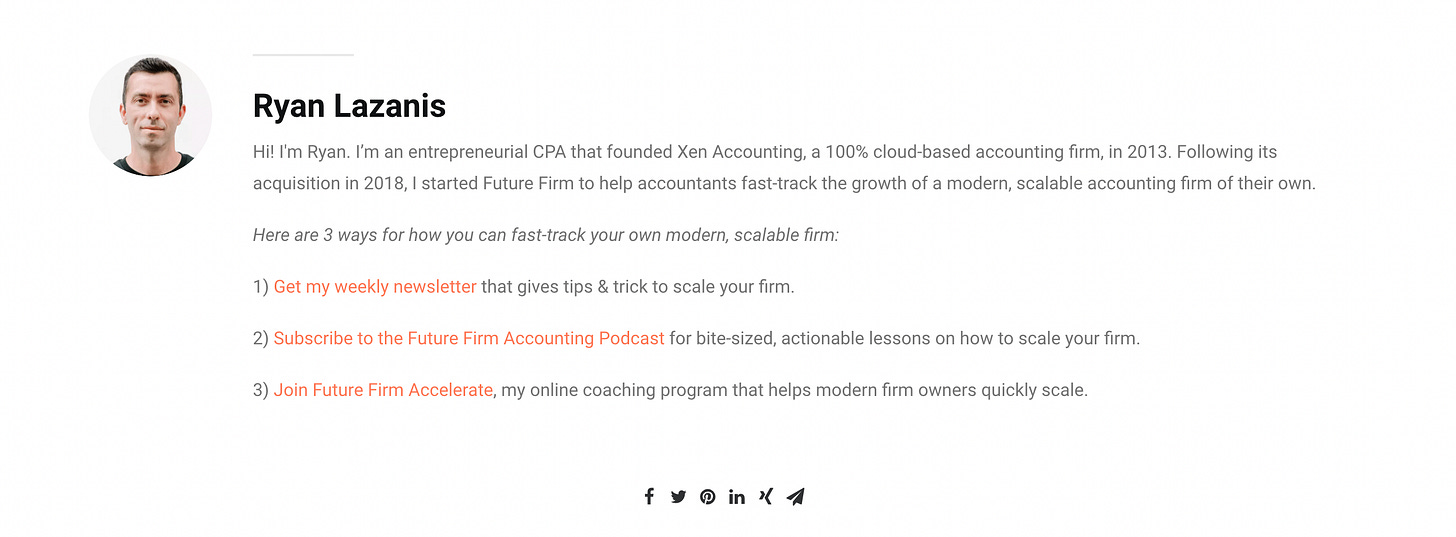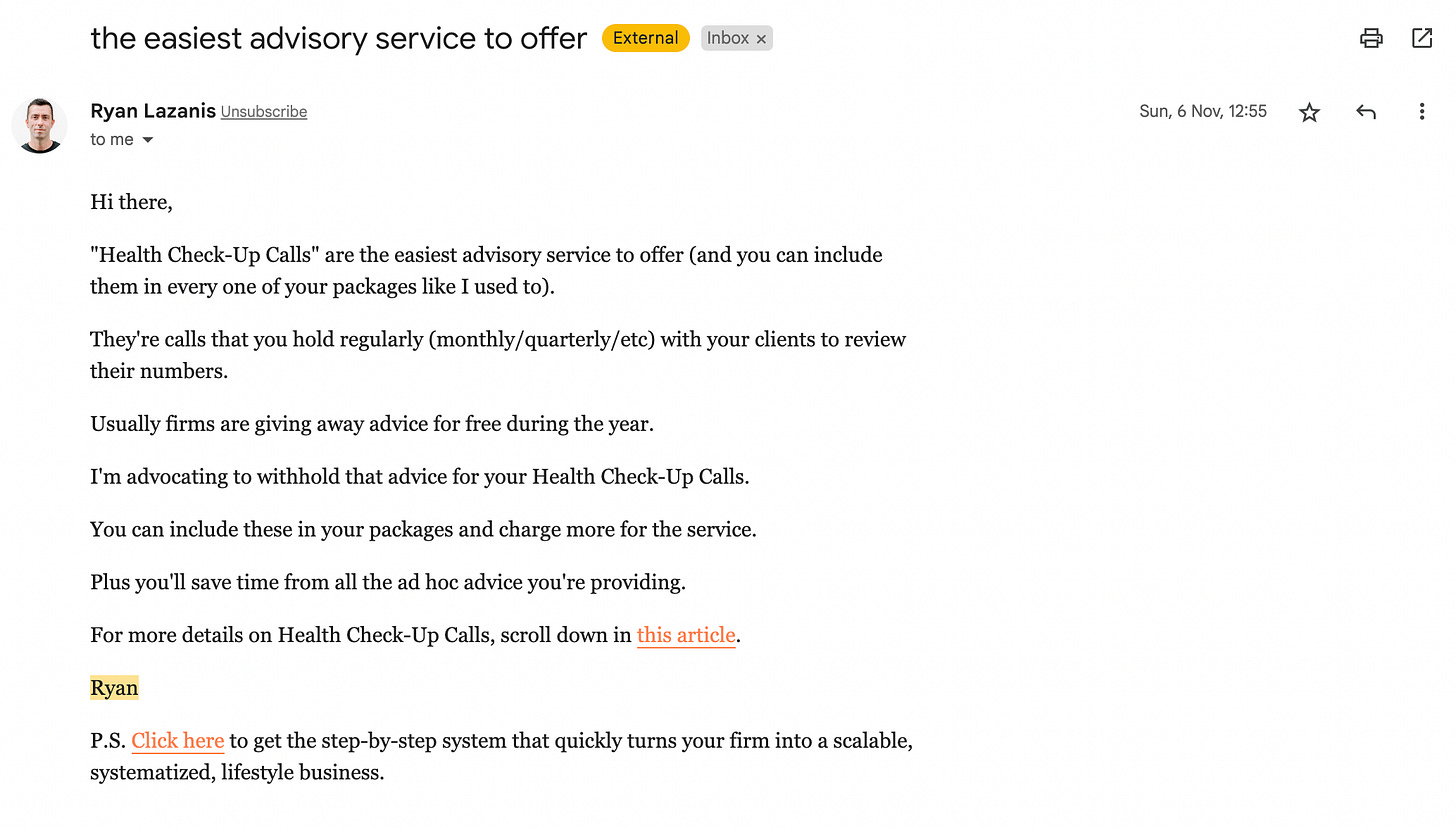Did somebody forward this to you? Please subscribe here and receive future posts as soon as we hit publish.
If you’re a regular reader you might have realised that we’re quite bullish when it comes to marketing strategy.
Too many firms fall into the trap of ‘random acts of marketing’ without a clear strategy underpinning what they’re doing and why.
The goal of these marketing teardowns is to highlight real-world examples of:
What marketing channels people are using
How they’re using them (what’s good, what can they do better)
And most importantly, how it all fits together into a cohesive strategy
We can share the theory, and it might make sense, but by sharing examples of what others are doing our hope is that it makes the theory feel more real.
First up in our targets is Ryan Lazanis.
Ryan is a CPA who built and sold a cloud accounting firm in Canada.
These days, he runs his Future Firm programme to help other firm owners scale.
In this teardown, you’ll learn:
The simple channel Ryan uses to drive 4.5K hits per month to his website
How Ryan uses a value ladder of call-to-actions to appeal to prospects that aren’t ready to work with him right now
Ryan’s email marketing formula to turn leads into customers
It’s worth adding that Ryan had no idea we were doing this...
Hey Ryan 👋
So everything included in this teardown is based on what we can find on social media channels, website, and email list.
Ready to tear it down with us? Here are 2 ways:
Watch the teardown above where we go through in detail exactly what Ryan does and why (including screen shares of his Linkedin, email marketing, and SEO dashboard)
Read the teardown article below where we break down the key concepts and even share our workings out as we go.
Enjoy!
Here’s what we’ll cover in this teardown:
Ryan’s high-level marketing strategy
This is what we’ve pulled together purely from what we can find online.
Ryan focuses on creating awareness and driving traffic from 2 key channels:
Social media (primarily Linkedin and Twitter)
Organic search (SEO)
It’s worth noting that:
Lots of firms fall into the trap of creating content for their blog and having no meaningful strategy to drive traffic to it. A good rule of thumb when creating content is spend 30% of time creating it and 70% of time distributing it.
This is incredibly focused. He’s not spreading himself thin across 3-5 social media channels and doing an average job, he’s focused on 1-2 and making them work well. We’ll share what he’s doing for each further down.
The goal of this social + SEO strategy is to get people on his site to consume his educational long-form blogs + podcast episodes. Once here, the next goal is lead capture so that Ryan can capture visitors’ contact details to put them into his email marketing sequence.
His email marketing sequence which we’ll unpack in more detail shortly consists of:
His newsletter
Educational emails
Offers
The goal of all of these is to add value, nurture, and ultimately sell his Future Firm Accelerate program.
Social media strategy
Ryan is a master of what we call ‘contextualising content’. In simple terms, it means taking content e.g. a blog from your website and repurposing it in a way that means it can be consumed natively on the platform it’s being shared on.
Let’s share an example…
In the example above, instead of just sharing a link to the blog/podcast episode, Ryan has:
Extracted the key points and used them to write a brief but educational Linkedin post. This means people on Linkedin can consume this, and engage with it, without having to leave the platform (most people scrolling on Linkedin want to stay on Linkedin not be dragged off to your blog)
Included a Call To Action (CTA) for people to learn more about this from his latest podcast episode with the link in the comments. Linkedin penalizes links in posts (which means your posts get fewer views) so by adding the link in the comments, you get around that
His approach to Twitter is also similar by creating ‘threaded tweets’ covering the key points of his blog or podcast. Click the example below to see the full thread.

Most of his posts across Linkedin/Twitter fall into these core content themes:
Educational
A link to a blog/podcast episode
A link to his latest newsletter
Behind the scenes
Events he’s at, things he’s involved in, other personal updates
Offers/Promo
Yes, you’re allowed to do this on social media on occasion but you have to find the balance between this + your educational content
SEO strategy
As well as driving traffic from social, Ryan also has an SEO strategy in place to capture traffic from search engines like Google.
And it seems to be working… this screenshot from SEMrush shows that he’s averaging 4.5K hits PER MONTH from organic search traffic which is huge.
Let’s unpack the SEO strategy Ryan is using on his blog…
Keyword research: Ryan has clearly researched keywords that his ideal clients (firms looking to automate and scale their firms) are interested in
He has blogs ranking for keywords like; accounting CRM software, accounting automation, pricing accounting services, accounting practice management software etc
Each of these keywords might only have 100 searches per month, but once you create multiple pieces of content, these volumes add up and begin to compound over time
SEO optimised content: Take this blog for example, you’ll notice:
The target keyword is used in the URL, title, first few paragraphs, table of contents, subheaders, and in the body of the blog
Images, bullet points, and headers are used to break up the text and make it easy to consume
Backlink strategy: Backlinks are an important part of increasing your domain authority. It’s hard to tell exactly what Ryan’s backlink strategy consists of. My best guess is he’s working with an SEO freelancer/agency to build backlinks on other blogs. Whatever he’s doing, it looks like it’s working!
Lead capture strategy
Once people land on Ryan’s site either from social or SEO, his first goal is to add value and educate, his second goal is to turn that visitor into a lead.
Here are a few ways he’s doing this really well…
1. Value-ladder
At the bottom of each of his blogs, you’ll notice the following ‘about’ section.
What’s great about this is the ‘value ladder’ of CTAs (Call To Actions) Ryan is using to appeal to people at different stages of their journey.
If they’re cold and just discovering his blog for the first time, they can subscribe to the weekly newsletter. Fairly low risk and an opportunity to receive more content.
If they’re a little warmer perhaps they’ll subscribe to his podcast.
And if they’re super warm/in-market for a coach right now (which the vast majority of visitors won’t be) then they can join his programme.
Related reading - Why 95% of business owners aren’t ready to work with you right now.
If your only Call To Action is ‘get in touch’ or similar, you’re ignoring the 95% of people that aren’t ready to work with you right now.
2. Newsletter landing page
Lots of websites do a terrible job of generating newsletter sign-ups.
That’s not your fault, it’s because most people don’t want to sign up for ‘another newsletter’.
Ryan recognises this, so instead of a generic subscribe call-to-action, he’s built a dedicated landing page featuring:
What’s included - “the tricks I used to scale my firm from scratch to sale in 5 years”
Social proof - “Join 7,639 other firm leaders who get my weekly tips & helpful content”
Testimonials - and lots of them!
My best guess is that this page should be converting 40-50% of visitors into leads. If it’s anything less than that Ryan then perhaps we can chat about it 😉
3. Website pop-ups
Put your feelings to one side. Do you hate popups? Probably. Can they still work? Yes.
I noticed that Ryan had a couple of pop-ups on his site (triggered by how far down I scrolled on the page) that tried to get me to opt-in for guides and other content in exchange for my email address.
Sadly I couldn’t get any screenshots since I closed them all down and they won’t reappear since I’m a repeat visitor.
Email marketing strategy
Once you’ve opted in for Ryan’s newsletter or other content pieces, you’ll enter his email marketing sequence.
This is broken down primarily into 3 types of emails:
1. Newsletter
Each week Ryan sends out a curated list of resources that he knows his ideal clients will benefit from. You can see an example here. Here are a few key points worth noting:
The structure is always the same. Ryan opens with a valuable tip/idea followed by links to 5 resources. Using the same structure makes it memorable and easy to consume for subscribers.
Weaved into the resources (which are often on other people’s websites/blogs) are Ryan’s own blogs/guides. This continues to nurture and add value to his subscribers.
At the end of EVERY email is a simple P.S. which says: “P.S. Want to quickly scale a 7-figure modern accounting firm that cuts your workload in half? Click here”
Including this in every email means that people are constantly reminded about the offer (a bit like seeing the same TV commercial hundreds of times)
It means you’re more likely to put it in front of somebody when the timing is right for them e.g. this month they might not have a need for coaching, but next month that might change and this same offer will be there
At the bottom of every email is a referral loop to encourage people to invite others to subscribe in return for free things - this encourages more subscribers to join at a low cost to Ryan
2. Educational emails
Short, sweet, and simple educational emails sharing one piece of advice or content.
See this example below. Notice what’s in the PS. section at the bottom again? 👀
Here’s another example, this time linking off to a blog on his site
3. Offers
The beauty of building your own email list is that it’s an audience you own (unlike social media where you’re at the mercy of the algorithms or Elon Musk).
And having your own audience means you can make offers as and when you need to.
As well as subtly offering his programme in the PS. of all his other emails, Ryan also sends dedicated ‘offer’ emails every now and again to encourage people to sign up.
This is absolutely fine to do if done in moderation and you have built enough trust and credibility up with your audience beforehand.
Final thoughts
We’ve unpacked A LOT in this tear-down (and we go into even more detail in the video recording at the top). Here are some of our final thoughts as we wrap up:
What do we like the most?
Matt - Inch wide & mile deep: Ryan’s strategy is super focused. He’s not trying 10 different marketing tactics, he’s got a few channels and he’s executing them at 100%
Jordan - The traffic strategy is solid. Ryan’s approach to social is great and 4.5K monthly hits from search traffic is huge for this niche and likely to be a good source of leads for Ryan.
What would we do differently?
Matt - Bring a bit more personality into the website with images and video. The content has a lot of personality but it doesn’t jump out on the website as much as it could.
Jordan - Test more content types out on Linkedin for example I’d like to see clips from podcasts shared as videos/audiograms as an alternative to mostly text posts. This could be interesting to see if it drives up engagement and podcast subscriptions.
Other thoughts
Have a clear path to revenue: Ryan has a very clear path from content on social media to sign-ups to his programme. Think about how you can do this for your firm.
Don’t base your marketing decisions on what you think people want or do. Base them on data.
Own your audience: Building an email list is the only true way to do this.
That’s all for this teardown.
Found this helpful? Please hit LIKE below.
Got additional thoughts or disagree with us? Leave a COMMENT.
Think this would be helpful for somebody else? Feel free to SHARE.
Until next time,
- Jordan & Matt
P.S. If you want to cheat like you’re in an 8th-grade math class again, here are the workings-out we made about his strategy before jumping on to record.














Share this post